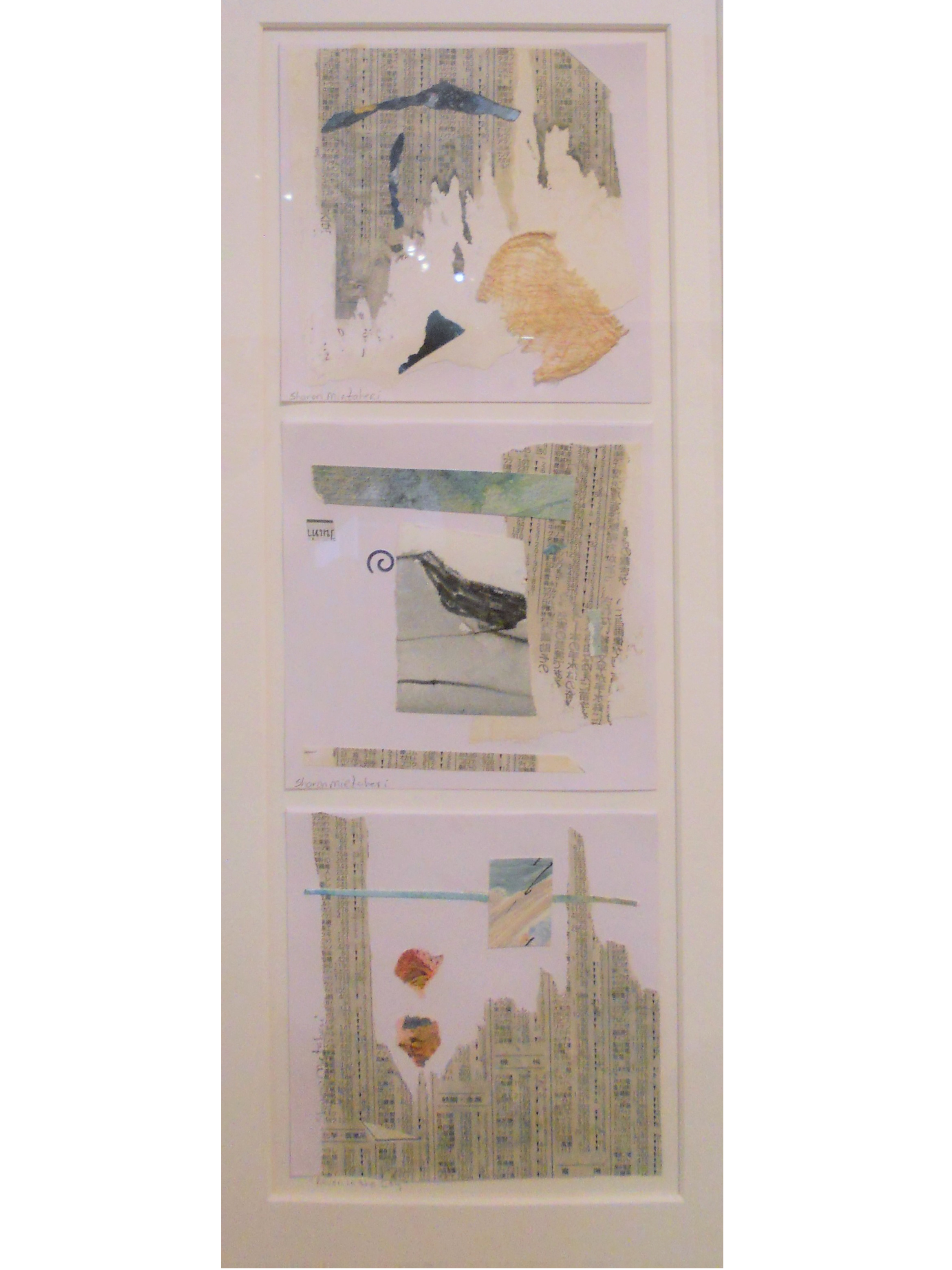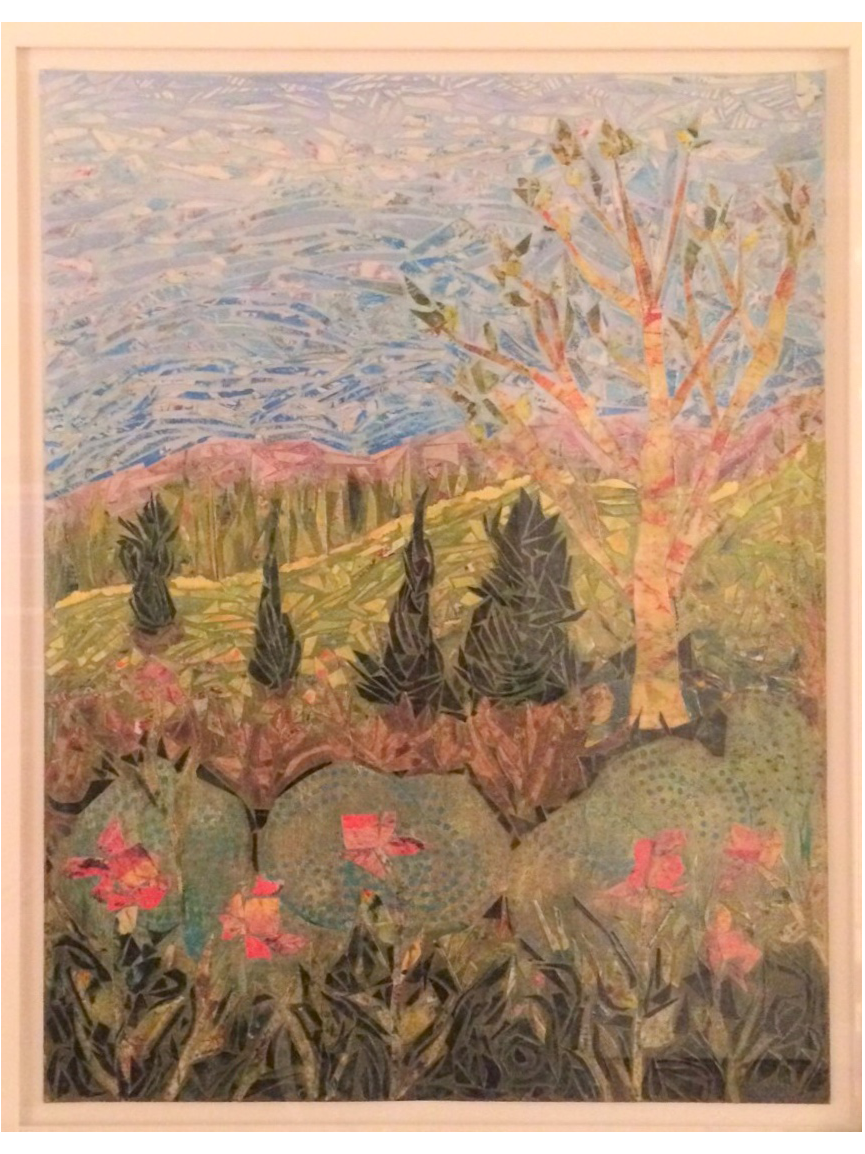


Flailing the Angel • 6’ x 4’ • Mixed-media on Masonite, oil paint, feathers, wax, costume jewelry, burlap, tin, photographs. • This piece was done in a visiting professor’s class while I was at Hollins. I had seen Thayer’s Angel oil painting at the Smithsonian Museum in D.C. and was gob smacked at the detail of her dress. This piece came to me in a series of dreams I had off and on all summer after the trip. That fall, I decided to take the collage class taught by the visiting professor so I could attempt to make it. We butted heads all semester over it. She wanted me to put many photos of my father over the surface, peeking out from the beer cans, and to flatten the metal can pieces that I had so laboriously cut out, intentionally ragged. I stepped back three feet from her when she suggested that before I gave her a piece of my mind. “You obviously do not get what this piece is about. I would never elevate him above her heart and head! The jagged tin is a metaphor for the danger my mother, siblings and I lived in constantly!” I lost all respect for her at that moment and decided I would listen to my inner voice no matter what grade I ended up with. Additionally, she was of no help on the mechanics of what glue to use to get the effect I wanted with the dress. I wanted it to stand out from the surface so I soaked the burlap in glue then held it in place until it dried. A glue gun worked for the beer can shards. I bought two cases of the beer and gagged the entire time I poured it down the drain. Then I used metal snips and spent several days cutting up the cans. The belt is a broken piece of my mother’s costume jewelry. I tried to envision how feathers would be attached to a scaffolding and used bits of a beeswax candle for that. Feathers were dipped in red oil paint. The photo of my mother was taken at Radford University at my sister’s graduation. We are standing in front of the fountain in the center of campus and the refracted light from it surrounds my mother like a halo in the photo. She died that night. I always saw my mother as an angel and saint. This piece is based on a poem I have written and pieces of the poem are tucked into the folds of the dress. I painted her arms, hands and neck with oil paint to look bruised, as she always was from my father’s weekly beatings. I wanted to give this piece to the Roanoke Rescue Mission but the CEO thought it might trigger trauma in those who are trying to heal from alcoholism. I respected that. The other place it might do some good is the art therapy department of the Carillion Medical School. Perhaps I was supposed to keep it so I could share it here. It is an example of how cathartic making art can be.

Fabric City-Scapes 1 • During the Covid lockdown, I decided to make art using all the fabric scraps my professor and friend, Nancy Dahlstrom, had given to me over the years. This was the result. I had mat board in every color imaginable that I had scavenged from the trashcans at Hollins during the seven years I was there. So even the substrate is salvaged material. Other than the fabrics, there are some slices of magazine pages in these collages. I am not a city person at all. My husband and I had just been to New York City to see the Metropolitan and Guggenheim Museums. It was my first visit to each of them and the trip was still on my mind. These works became Christmas presents for Nancy and two other friends from Hollins.

Fabric City-Scapes 2

Fabric City-Scapes 3

Crow in the City • Paper collage on mat board • Newspaper, hand inked papers, drawing.

John’s Trees • Collage • Hand-inked paper, decorative paper, mounted on mat board • Thank you, visiting professor, for telling me my painting sucked. “The quality of the paint is poor,” she said. This assessment moved me to cover the painting with bits of paper created by inking sheets of paper at the end of a long art-making day in the printmaking lab. I loathed wasting the ink on the glass table after I was done so I treated myself to playtime and came up with some magical printed papers and mat board pieces, both trash finds. I first cut the papers into free-form contorted rectangles, triangles, squares and crescent shapes. I pasted them over the rough painting underneath (that so offended), not letting the pieces touch, allowing a reveal the “poor paint” below. I found I liked what the pieces were becoming. The pattern was intricate and had a motion not achieved with just paint. I started at the bottom and worked upwards. Finding just the right paper from my stash was fairly easy as I have a n eye for color matching. I always stuck to the color of the background underpainting. Only for the darkest green part of the trees and the darkest brown earth color did I use bought decorative paper. It is work I can fall into and get lost—my reason for being creative. I would cut a small pile of pieces in the color I needed, then turn them all right side up. I had an epiphany. Each small piece was its very own individual work of art. Each lovely in its own way and I found myself loving them. I took the time to admire each one like a precious flower. Some pieces were not inked up very well but I found they had a role to play, too and fit into just at the right spot. And it occurred to me that my little pieces were a lot like people in many ways; all unique, all beautiful in their individual way. Even pieces not perfect fit in somewhere and had usefulness; a place. Soon it went even faster, this method of finding the right piece for the right spot. I was conscious of going to the cut pile, picking a random piece, gluing, then without thought going straight to the spot “they wanted to be.” “So is this where you want to be? Okay!” I even said it out loud several times as the piece fit perfectly size wise and color wise. Nine out of ten times it fit perfectly and I began to trust that this would happen most of the time. It went quickly and time fell away.